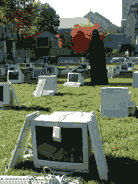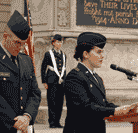Comment on this article
For the Environment School, Compostable Forks
January/February 2004
by James McElroy ’95
In the fall of each of his five years as dean of the School of Forestry and Environmental Studies, Gus Speth '64, '69JD, has hosted a picnic for students, faculty, and staff at his house in Guilford, Connecticut. At this year’s affair, a hundred-plus environment school folk made the most of a Saturday afternoon at their dean’s 18th-century farmhouse and its sloping four acres of lawn and woods. Kids played soccer near the Speth family’s fenced-in concord grape patch while some of the adults talked shop over slices of blueberry and raspberry pie. (“Is it just the leaves?” one young woman was overheard asking another. “Or is it also the roots?”) Others took turns climbing the narrow stairs that led to an observation deck on the roof of the house. Speth took a moment to show Professor of Forest Ecology Tom Siccama evidence that deer had swiped some of the raspberries growing on the edge of his lawn.
Then there was the clutch of picnickers gathered around the trash cans. As guests threw away their used plates, napkins, cups, and utensils, Yale’s recycling coordinator, C. J. May '89MES, held court. For this was no typical Yale picnic. As heralded by the handwriting on May’s dry-erase board, this was “Yale’s First ZERO WASTE Event.” The disposable cups, knives, forks, and spoons, purchased from a company called Biocorp North America, were made of totally biodegradable corn and potato starch. And the Biocorp paper plates were not coated with the wax or plastic that normally prevents such items from decomposing.
The trash produced during the picnic would be collected in cornstarch Biocorp trash bags and thrown on a large compost heap at the new Yale Farm on Science Hill, where it would simply return to whence it came.
“We’ve tried out these Biocorp products at other events with normal Yalies,” May said as he positioned a fresh Biocorp bag into a trash can. “But it’s wonderful to come to an event like this where everyone is like, ‘Ooh-ooh-ooh!’” May was wearing a red, white, and blue “America Recycles Day” cap and a blue “Yale Recycling” sweatshirt with the words “Talk Trash To Me” printed on the back.
“Yep! It’s all made of cornstarch!” May said to some students dumping their used cups.
“We can eat them?” said a grinning young man.
“Well,” May said, “I wouldn’t want to eat them.”
“What about those?” asked a young woman, pointing to a pile of tiny yellow plastic containers at May’s feet.
“I didn’t know the caterer would be supplying single-service butter tubs,” said May, a note of disappointment in his voice. “Those are not biodegradable.”
Suddenly, he walked briskly away from the trash cans, cupped his hands around his mouth and hollered: “Hold on to your fork! We don’t have enough forks! If you’re going to have pie, hold onto your forks!”
Returning to the trash cans, May explained that he had not thought to buy extra forks for dessert. “People just throw the fork away after they use it for their salad or whatever. They don’t think to reuse it for the pie.”
The cost of the biodegradable supplies was 12 times the norm. “But,” said May, “if you buy in larger volume, you get a better price. If this works out, I could buy thousands and just keep them on hand for events like this. Even though this stuff is biodegradable, I don’t think it goes bad.”

Dean Brodhead to be Duke’s President
by Mark Alden Branch ’86
Richard Brodhead’s zip code has been 06520 since—well, about as long as there have been zip codes. He came to Yale in 1964 as a member of the Class of 1968, stayed on to get a PhD in 1972, and became an assistant professor of English in that same year. He has taught at Yale ever since and has served as dean of Yale College since 1993. But now, after 40 years, Brodhead has found something to lure him away from Yale: on July 1, he will become president of Duke University.
“I’ve had a wonderful life at a great institution,” Brodhead said at the Duke press conference where his appointment was announced. “I may be America’s least disaffected employee.” But he said his “curiosity was piqued” when Duke approached him about succeeding Nannerl Keohane '67PhD as its president. “I’ve been dean for 11 years. I’ve done most of what I can in the job,” he says.
Most recently, Brodhead oversaw the first comprehensive review of Yale’s curriculum in 30 years. The faculty are now beginning to implement some of the recommendations in the review document, known as the Brodhead Report. (See page 42.) But Brodhead says he has no regrets about leaving before the work of turning the report’s ideas into reality is done. “I couldn’t have left last year because we still had to hammer it all out,” he says. “But now, there is a clarity of vision, and other people can move it forward. Besides, it never was true that that report was all mine or that its enactment rested on me. It was a huge joint project.”
Brodhead’s deanship, the third longest in Yale history, has won praise from both students and faculty. President Richard Levin, who appointed him to a third five-year term last year, called him “one of the finest educators of his generation and one of the greatest deans in Yale’s 300-year history” and said it would be “difficult to imagine Yale without him.” In addition to his leadership skills, most will probably remember him for his way with words, which is as apparent in conversation as it is in addresses to incoming freshmen or graduating seniors. When he was reappointed, one faculty member said he “is to articulation what Michael Jordan was to basketball.”
Brodhead says he can look back on his tenure with satisfaction. “No one could imagine what a continual source of pride and joy it was to hold this job, every day,” he says.
President Levin was expected to appoint a search committee this month to find a new dean for the college. In the meantime, Brodhead, who has been a fixture at Yale athletic events, is looking forward to becoming a Blue Devil. “I presume that the president gets guaranteed tickets to the basketball games,” he says. “If not, I hope someone will tell me right away.”

Madame Curie’s Daughters
by Adrian Brune
In their late-nineteenth-century “potato cellar” of a Paris laboratory, Marie and Pierre Curie spent years testing the practical applications of her discovery of radium. They finally discovered its use for treating malignant tumors, for which Marie was awarded the Nobel Prize in physics, her first of two. In November, Yale marked the centennial of that first Nobel with a conference highlighting the achievements of and challenges facing female scientists.
At the symposium’s central panel, “Frontiers in Chemistry, Astrophysics, and Biology,” three of the most distinguished female scientists in the world presented recent work. The Yale scientist on the panel, Sterling Professor of Molecular Biophysics and Biochemistry Joan Steitz, discussed her studies of small ribonuclearproteins and the role they play in revealing genetic links to complex diseases such as lupus and cancer.
Curie, who in 1911 was prevented from entering the Academy of Science, might have appreciated the second panel, a discussion of women’s roles, opportunities—and obstacles—in science and technology. “There’s no surer way to strike the death knell of science than to have an education program that discourages highly qualified scientists from entering the field,” said Princeton president Shirley Tilghman, who is a professor of life sciences there. “Modern research universities are not ivory towers; they are of the world, and they shape the world.”
In Curie’s spirit of educating future generations, Yale welcomed girls from area high schools to tour the medical library’s Curie exhibit, featuring a photograph of Curie receiving her honorary doctorate from Yale in 1921. “On Curie’s first tour of America, President Warren G. Harding presented her with one gram of radium,” said Norma Thompson, associate director of the Whitney Humanities Center. “It was a gift, he said, from American women in recognition of her status as a role model for budding scientists everywhere.”

Once a Yalie, Always a Yalie
by Adrian Brune
Helping Yale graduates stay Blue at heart is the job of the Association of Yale Alumni. This year, the AYA inaugurated a new approach to the task.
Upon leaving Yale, every graduate becomes a member of the AYA, which supports the Yale community around the country and serves as an interface between the alumni and the university. To most, AYA membership simply means their personal e-mail addresses morph from @yale.edu to @aya.yale.edu, or that every five years they receive a shower of reunion notices. However, AYA executive director Jeff Brenzel '75, the AYA board, and a core of dedicated volunteers are attempting to reach out to uninvolved alumni, to remind them that they have a place at Yale.
One mainstay of the AYA has been a twice-annual assembly of delegates who represent alumni organizations: clubs, classes, graduate and professional associations, and personal-interest groups. This November, a new assembly program not only doubled the number of alumni organization leaders attending—to more than 500—but focused on how they can grow their organizations and re-establish connections for more alumni. At one panel, Beth Camp '88 told how she won over classmates who were convinced they weren’t accomplished or wealthy enough to attend the 15th reunion. “We emphasized that if you want to connect Yale alumni to Yale, work on connecting them to each other,” she said. “Because what is Yale? It’s not the campus. Not the faculty. Not the prestige. Not the athletics. It’s Yale people. We had 25 percent of our class attending, versus the previous record of 20 percent.”
Created to provide ways for alumni and university officials to communicate, the AYA “has also evolved into a working organization providing services to alumni,” says Brenzel. The AYA posts dozens of class message boards, listservs, and learning opportunities on its website (www.aya.yale.edu), and runs many other programs for alumni involvement. “The AYA fosters a sense of community not related to asking for money,” says assembly delegate Richard Cacciato '81. “It’s our tool for generating goodwill for Yale in the real world.”  |





